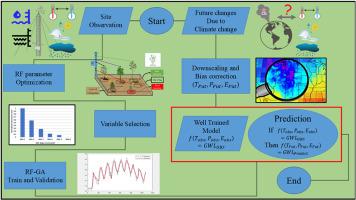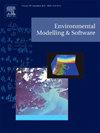采用混合机器学习算法对气候变化下的地下水位预测进行变量敏感性分析
IF 4.8
2区 环境科学与生态学
Q1 COMPUTER SCIENCE, INTERDISCIPLINARY APPLICATIONS
引用次数: 0
摘要
有关气候变化的研究在很大程度上忽视了地下水位(GWL)对大气条件的延迟反应。这一差距至关重要,因为地下水位的波动可能导致土地沉降等危害。本研究通过确定关键变量的最佳延迟时间来解决这一问题,从而提高地下水位预测的准确性。输入数据的过程包括以 42 种组合形式引入气象和水文变量。气候变化情景下的气象数据是通过对共享社会经济路径(SSP)情景下的大气环流模型(GCMs)输出结果进行降尺度处理而获得的。迄今为止,还没有类似的研究尝试对如此广泛的延迟时间组合进行排序。本研究通过引入输入变量的最佳组合,改进了随机森林和遗传算法(RF-GA)混合预测。调查评估了传统随机森林(RF)和 RF-GA 在模拟地下水波动方面的性能。变量敏感性分析结果表明,与气象变量相比,流域排水量具有更高的变量重要性(VI)。验证部分的结果还表明,RF-GA 的性能优于按默认超参数运行的 RF。温度和蒸发的延迟时间分别为 3 个月和 2 个月。研究发现,降水量是唯一一个具有 2 个月和 4 个月两种延迟时间的变量。此外,变量多和变量少的组合表现不佳。预测结果表明,在 SSP1-2.6 低排放方案和 SSP5-8.5 高排放方案下,Silakhor 平原的平均 GWL 分别增加了 6.8 厘米和 7.1 厘米。本文章由计算机程序翻译,如有差异,请以英文原文为准。

Variable sensitivity analysis in groundwater level projections under climate change adopting a hybrid machine learning algorithm
Studies on climate change have largely overlooked the delayed response of Ground Water Levels (GWL) to atmospheric conditions. This gap is critical because fluctuations in GWL can lead to hazards like land subsidence. This study addresses the issue by identifying optimal delay times for key variables, which improves GWL projection accuracy. The input data process consists of introducing meteorological and hydrological variables in the form of 42 combinations. Meteorological data under climate change scenarios were obtained by downscaling outputs from the General Circulation Models (GCMs) within the Shared Socio-economic Pathways (SSP) scenarios. So far, no similar study has attempted to rank such a wide array of delay time combinations. This study improves hybrid Random Forest and Genetic Algorithm (RF-GA) projections by introducing the best combination of input variables. The investigation assessed the performance of both the conventional Random Forest (RF) and the RF-GA in simulating groundwater fluctuations. The variable sensitivity analysis results indicated that watershed discharge holds a higher Variable Importance (VI) compared to meteorological variables. The findings in the validation section also demonstrated that the RF-GA outperformed an RF that runs on default hyperparameters. Temperature and evaporation show a 3 and 2-month delay time, respectively. It was discovered that precipitation was the only variable with two possible delay times of 2 and 4-month. Also, combinations with many and few variables performed poorly. The projection results indicate an increase of 6.8 and 7.1 cm in the average GWL in the Silakhor plain under the low-emission SSP1-2.6 and high-emission SSP5-8.5 scenarios, respectively.
求助全文
通过发布文献求助,成功后即可免费获取论文全文。
去求助
来源期刊

Environmental Modelling & Software
工程技术-工程:环境
CiteScore
9.30
自引率
8.20%
发文量
241
审稿时长
60 days
期刊介绍:
Environmental Modelling & Software publishes contributions, in the form of research articles, reviews and short communications, on recent advances in environmental modelling and/or software. The aim is to improve our capacity to represent, understand, predict or manage the behaviour of environmental systems at all practical scales, and to communicate those improvements to a wide scientific and professional audience.
 求助内容:
求助内容: 应助结果提醒方式:
应助结果提醒方式:


